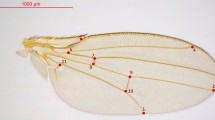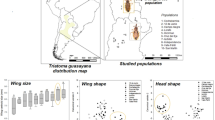Abstract
In the present study, we tested the hypothesis whether flight-related traits such as wing area, flight-muscle ratio, wing loading and dispersal yield evidence of geographical variation in nine wild-collected as well as laboratory-reared (at 21°C) latitudinal populations of Drosophila melanogaster from the Indian subcontinent. We observed positive clinal variation in the wing–thorax ratio, wing aspect ratio and wing area, along a latitudinal gradient for both the sexes. In contrast, geographical changes in three parameters of flight ability, i.e. flight-muscle ratio, wing loading and dispersal, showed negative correlation withlatitude. On the basis of isofemale line variability, we observed positive correlation of wing loading with flight-muscle ratio as well as dispersal behaviour in both the sexes. We also found positive correlation between duration of development and wing area. Interestingly, southern populations of D. melanogaster from warm and humid habitats exhibited higher flight-muscle ratio as well as the higher wing loading than northern populations which occur in cooler and drier climatic conditions. Laboratory tests for dispersal-related walking behaviour showed significantly higher values for southern populations compared with northern populations of D. melanogaster. Multiple regression analysis of geographical changes in flight-muscle ratio, wing loading as well as walking behaviour as a function of average temperature and relative humidity of the origin of populations in wild-collected flies have suggested adaptive changes in flight-related traits in response to steeper gradients of climatic factors in the Indian subcontinent. Finally, adaptive latitudinal variations in flight-related traits in D. melanogaster are consistent with results of other studies from different continents despite differences due to specific climatic conditions in the Indian subontinent.




Similar content being viewed by others

References
Alexander R. M. 1983 Animal mechanics. Blackwell Scientific Publications, London, UK.
Azevedo R. B. R., James A. C., McCabe J. and Partridge L. 1998 Latitudinal variation of wing: thorax size ratio and wing-aspect ratio in Drosophila melanogaster. Evolution 52, 1353–1362.
Brodsky A. K. 1994 The evolution of insect flight. Oxford University Press, Oxford, UK.
Coyne J. A. and Beecham E. 1987 Heritability of two morphological characters within and among natural populations of Drosophila melanogaster. Genetics 117, 727–737.
Curtsinger J. W. and Laurie-Ahlberg C. C. 1981 Genetic variability of flight metabolism in Drosophila melanogaster. I. Characterization of power output during tethered flight. Genetics 98, 549–564.
Dieckermann N., O’Hara B. and Weisser W. 1999 The evolutionary ecology of dispersal. Trends Ecol. Evol. 14, 88–90.
Dudley R. 2000 The biomechanics of insect flight: form, function, evolution. Princeton University Press, Princeton, USA.
Ellington C. P. 1984 The aerodynamics of hovering insect flight. VI. Lift and power requirements. Phil. Trans. R. Soc. London B 305, 145–181.
Endler J. A. 1977 Geographic variation, speciation and clines. Princeton University Press, Princeton, USA.
Frazier M. R., Harrison J. F., Kirkton S. D. and Roberts S. P. 2008 Cold rearing improves cold-flight performance in Drosophila via changes in wing morphology. J. Exp. Biol. 211, 2116–2122.
Gilchrist G. W. and Huey R. B. 2004 Plastic and genetic variation in wing loading as a function of temperature within and among parallel clines in Drosophila subobscura. Integrative and Comp. Biol. 44, 461–470.
Greenewalt C. H. 1962 Dimensional relationship for flying animals. Smithsonian Institution, Washington, USA.
Hoffmann A. A. and Weeks A. R. 2007 Climatic selection on genes and traits after 100 year-old invasion: a critical look at the temperate-tropical clines in Drosophila melanogaster from eastern Australia. Genetica 129, 133–147.
Imasheva A. G., Bubli O.A. and Lazebny O. E. 1994 Variation in wing length in Eurasian natural populations of Drosophila melanogaster. Heredity 72, 508–514.
James A. C., Azevedo R. B. R. and Partridge L. 1995 Cellular basis and developmental timing in a size cline of Drosophila melanogaster. Genetics 140, 659–666.
James A. C., Azevedo R. B. R. and Partridge L. 1997 Genetic and environmental responses to temperature of Drosophila melanogaster from a latitudinal cline. Genetics 146, 881–890.
Junge-Berberovic R. 1996 Effect of thermal environment on life histories of free living Drosophila melanogaster and D. subobscura. Oecologia 108, 262–272.
Kammer A. E. and Heinrich B. 1978 Insect flight metabolism. Adv. Insect Physiol. 13, 133–228.
Lehmann F. O. 1999 Ambient temperature affects free-flight performance in the fruit fly Drosophila melanogaster. J. Comp. Physiol. B 169, 165–171.
Marden J. H. 1989 Body building dragonflies: costs and benefits of maximizing flight muscle. Physiol. Zool. 62, 505–521.
Mikasa K. and Narise T. 1979 The Relation between dispersive behaviour and temperature in Drosophila melanogaster. I. Dispersal patterns. Jpn. J. Genet. 54, 217–228.
Nunney L. 1996 The response to selection for fast larval development in Drosophila melanogaster and its effect on adult weight: an example of a fitness trade-off. Evolution 50, 1193–1204.
Nunney L. and Cheung W. 1997 The effect of temperature on body size and fecundity in female Drosophila melanogaster, Evidence for adaptive plasticity. Evolution 51: 1529–1535.
Parkash R., Karan D. and Munjal A. K. 1998 Geographical divergence for quantitative traits in colonizing populations of Drosophila kikkawai from India. Hereditas 128, 201–205.
Partridge L. and French V. 1996 Thermal evolution of ectotherm body size: Why get big in the cold? In Animals and temperature: phenotypic and evolutionary adaptation (ed. I. A. Johnston and A. F. Bennett), pp. 265–292. Cambridge University Press, Cambridge, UK.
Reed S. C., Williams C. M. and Chadwick L. E. 1942 Frequency of wing-beat as a character for separating species, races and geographic varieties of Drosophila. Genetics 27, 349–361.
Roff D. A. and Fairbairn D. J. 2001 The genetic basis of dispersal and migration, and its consequences for the evolution of correlated traits. In Dispersal (ed. J. Colbert, E. Danchin, A. A. Dhondt and J. D. Nichols), pp. 191–202. Oxford University Press, Oxford, UK.
Stalker H. D. 1980 Chromosome studies in wild populations of Drosophila melanogaster. II. Relationship of inversion frequencies to latitude, season, wing-loading and flight activity. Genetics 95, 211–223.
Starmer W.T. and Wolf L. L. 1989 Causes of variation in wing loading among Drosophila species. Biol. J. Linn. Soc. 37, 247–261.
Stevenson R.D. and Josephson R.K. 1990 Effects of operating frequency and temperature on mechanical power output from moth flight muscle. J. Exp. Biol. 198, 61–78.
Unwin D. M. and Corbet S. A. 1984 Wingbeat frequency, temperature and body size in bees and flies. Physiol. Entomol. 9, 115–121.
Van’t Land J., Zwaan B. J., Van Putten W. F., Kamping A. and Van Delden W. 1999 Latitudinal variation in wild populations of Drosophila melanogaster: heritabilities and reaction norms. J. Evol. Biol. 12: 222–232.
Zwann B. J., Billsma R. and Hoekstra R. F. 1995 Artificial selection for developmental time in Drosophila melanogaster in relation to the evolution of ageing: direct and correlated responses. Evolution 49, 635–648.
Acknowledgements
We are indebted to anonymous reviewers for constructive comments that improved this manuscript. Financial assistance (F 41-823/2012/SR) from University Grants Commission, New Delhi is gratefully acknowledged.
Author information
Authors and Affiliations
Corresponding author
Additional information
[Bhan V., Parkash R. and Aggarwal D. D. 2014 Effects of body-size variation on flight-related traits in latitudinal populations of Drosophila melanogaster. J. Genet. 93, xx–xx]
Rights and permissions
About this article
Cite this article
BHAN, V., PARKASH, R. & AGGARWAL, D.D. Effects of body-size variation on flight-related traits in latitudinal populations of Drosophila melanogaster . J Genet 93, 103–112 (2014). https://doi.org/10.1007/s12041-014-0344-5
Received:
Revised:
Accepted:
Published:
Issue Date:
DOI: https://doi.org/10.1007/s12041-014-0344-5



